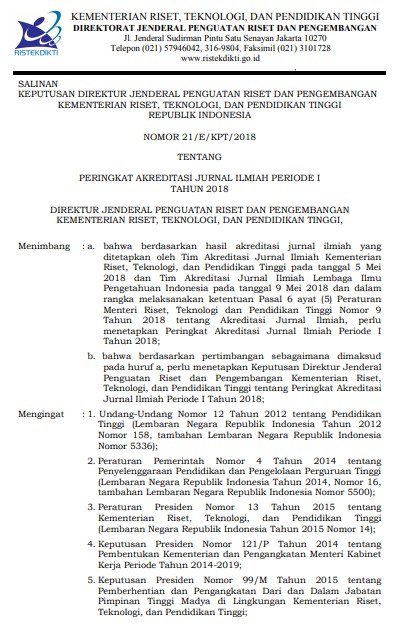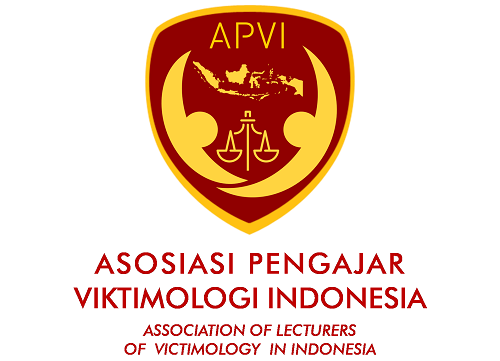Indication of Source - The Protection of Tenun Ikat Sumba to Encourage The Economy of The Local Community
Abstract
Tenun ikat Sumba is one craft of the Nusa Tenggara community used in worship services. The use of natural dyes in tenun ikat Sumba is an economic commodity that should be empowered to increase the economy of the Sumba community. The economic improvement of tenun ikat Sumba begins with an indication of source protection which should be given by the local government of Nusa Tenggara. This is a descriptive analytical study on the need of the local government to enforce the protection of tenun ikat Sumba through the inclusion of tenun ikat Sumba in a local government decree as a declarative effort in line with the mandate of Article 63 of Law Number 20 Year 2016 on Marks and Geographical Indications. Protection of indications of source by the local government is expected to encourage the economic progress of the local community, especially Sumba women, as well as the preservation of the culture of the local Sumba community.
Keywords : Indication of source, tenun ikat Sumba, local community
Full Text:
PDFReferences
Etika Ari Susanti, et all, “pengembangan Ekonomi lokal dalam Sektor Pertanian”, Jurnal Administrasi Publi, 1:4, 2013
Irene Calboli, “Time To say Cheese and smile At Geographical Indication of origin? International Trade and Local Develompment in The Unites States”, Houston Law Review, 53:373, P.2, 2015
Jeffrey Neilson, “ The Politics of Place: Geographical identities along coffee suplly chain from toraja to Tokyo”, In Niels Fold and Bill Pritchard (Eds.), Cross-Continental Food Chains, (pp. 193-206). London: Routledge imprint of Taylor & Francis, (2004)
Mariana Takandjandji, ‘Tingkat Pemanfaatan Tumbuhan Penghasil Warna pada Usaha Tenun Ikat di Kabupaten Sumba Timur”, Jurnal Penelitian Hutan Tanaman, Vol. 12 No. 3, 2015, hlm. 223–237 , [25/11/2017].
Martin Gasser et all, “pembangunan Ekonomi Lokal Dalam Siatuasi Pasca Krisis: Panduan Operasional”, Organisasi Perburuhan Internasional (ILO), 2005, hlm.25
Marina Jovicevic Simin, Pedrag Jovicevic and Srdan Novakovic, “ Appelation of Geographical Of origin As generator Of National Competitiveness”, Economics Agriculture Journal, 2:63, PP.567-583
Geovanni Belletti, “Geographical Indication, Public Goods, and Sustainable Development: The Roles of Actors Strategies and Public Policy”, World Development, Vol.98, PP. 45-57, 2017
Miranda Risang Ayu, Geographical Indications Protection in Indonesia Based on Cultural Rights Approach, Jakarta: Nagara, 2009,hlm 219
Sarah Besky, The Labor of terroir and the terroir of labor: Geographical Indication and Darjeeling tea Planataion”, Agric Hum Values, vol 31, PP 83-96,2014
The World Intellectual Property Organization (WIPO) and USPTO, “ Introduction to geographical indication and recent development in the world Intellectual Property Organization”, Worldwide Symposium On Geographical Indication, san Francisco, 9-11 Juli 2003
The Paris Convention for Protection of lndustrial Property of 1883 and the 1911 Revision, selanjutnya disebut Konvensi Paris, dibuka untuk penandatanganan sejak 13 Januari 1968, Pasal 1, 7, 10, 10bis, 10ter (diberlakukan sejak 26 April atau 15 Mei 1970).
Zhiguo SUN, Zhiang LIU and Rugang ZHONG, “protection of National Geographical Indication Product of Coptis Geoherbs”, Medical Plant, 4:3, P.96-98, 2013
Undang-Undang Nomor 20 Tahun 2016 Tentang Merek dan Indikasi Geografis
DOI: https://doi.org/10.20884/1.jdh.2019.19.2.2280
Refbacks
- There are currently no refbacks.
JURNAL DINAMIKA HUKUM Indexed by :
 | Jurnal Dinamika Hukum | |
| Faculty of Law, Universitas Jenderal Soedirman | Copyright of Jurnal Dinamika Hukum | |
| Yustisia IV Building, Law Journal Center | ISSN 2407-6562 (Online) ISSN 1410-0797 (Print) | |
| Purwokerto, Central Java, Indonesia, 53122 | JDH is licensed under a Creative Commons Attribution 4.0 International License | |






